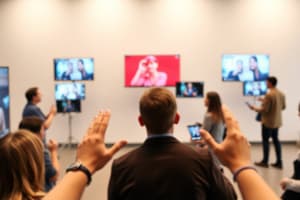Podcast
Questions and Answers
What does framing in mass communication primarily involve?
What does framing in mass communication primarily involve?
- Providing identical coverage across various media platforms
- Highlighting certain events and placing them within a specific context (correct)
- Eliminating all context to promote an objective view
- Minimizing the importance of events to reduce public concern
What effect does framing have on the perception of reality?
What effect does framing have on the perception of reality?
- It enables an infinite number of realities to coexist (correct)
- It solely emphasizes physical attributes of events
- It ignores cultural influences and focuses on facts
- It restricts reality to a singular interpretation
In the context of media framing, what does 'salient' refer to?
In the context of media framing, what does 'salient' refer to?
- Elements that are highlighted or made more prominent (correct)
- Information that is irrelevant to the understanding of events
- Details that are unimportant and overlooked
- Context that remains constant across different platforms
How does framing interact with cultural influences?
How does framing interact with cultural influences?
What is a key component of agency as it relates to framing?
What is a key component of agency as it relates to framing?
What is a key characteristic of discourse according to the provided content?
What is a key characteristic of discourse according to the provided content?
How do we give meaning to things according to the discussed concepts?
How do we give meaning to things according to the discussed concepts?
Which of the following examples illustrates social construction?
Which of the following examples illustrates social construction?
In the context of discourse, power is expressed through which mechanism?
In the context of discourse, power is expressed through which mechanism?
What does the concept of 'framing' refer to in contrast to structuralism?
What does the concept of 'framing' refer to in contrast to structuralism?
What can lead to misunderstanding and conflict between different social groups?
What can lead to misunderstanding and conflict between different social groups?
How can social constructions change over time?
How can social constructions change over time?
What characterizes researchers engaged in poststructuralism and discourse analysis?
What characterizes researchers engaged in poststructuralism and discourse analysis?
What is a significant consequence of social constructs like hegemony and discourse?
What is a significant consequence of social constructs like hegemony and discourse?
Which statement accurately reflects the nature of hegemonies within cultures?
Which statement accurately reflects the nature of hegemonies within cultures?
What is the primary difference in framing between the Korean and American articles?
What is the primary difference in framing between the Korean and American articles?
Which theory suggests that frequent framing will lead people to accept that frame as truth?
Which theory suggests that frequent framing will lead people to accept that frame as truth?
In what way does context affect the meanings generated by a frame?
In what way does context affect the meanings generated by a frame?
How do frames relate to cultural schemas within a society?
How do frames relate to cultural schemas within a society?
What role does power play in communication according to the content?
What role does power play in communication according to the content?
What does the Spiral of Silence theory suggest about societal communication?
What does the Spiral of Silence theory suggest about societal communication?
How does agenda-setting theory influence public perception?
How does agenda-setting theory influence public perception?
What limits the agency of actors when framing messages?
What limits the agency of actors when framing messages?
What is the concept of hegemony primarily concerned with?
What is the concept of hegemony primarily concerned with?
In poststructuralism, what does the term 'death of the author' refer to?
In poststructuralism, what does the term 'death of the author' refer to?
What does the term 'intersubjective process' imply in the context of poststructuralism?
What does the term 'intersubjective process' imply in the context of poststructuralism?
Which of the following best describes the relationship between denotation and connotation in poststructuralism?
Which of the following best describes the relationship between denotation and connotation in poststructuralism?
According to poststructuralist thought, what is a key factor in determining what is accepted as true and real?
According to poststructuralist thought, what is a key factor in determining what is accepted as true and real?
What is meant by the term 'semiology' in the context of poststructuralism?
What is meant by the term 'semiology' in the context of poststructuralism?
How does Antonio Gramsci's view on hegemony differ from traditional Marxist perspectives?
How does Antonio Gramsci's view on hegemony differ from traditional Marxist perspectives?
What is one implication of poststructuralist thought for the interpretation of language?
What is one implication of poststructuralist thought for the interpretation of language?
Flashcards
Media Framing
Media Framing
The way the media presents information, emphasizing certain aspects and framing it within a specific context, influencing how we interpret events.
Framing
Framing
The process of making certain aspects of reality more prominent or less noticeable, influencing our understanding of the situation. It shapes how we see the world and how we interpret what we see.
Natural Frames
Natural Frames
Frames that are based on natural laws and scientific principles, such as how a bomb explodes or the physical reactions to a stimulus.
Social Frames
Social Frames
Signup and view all the flashcards
Agency and Structure
Agency and Structure
Signup and view all the flashcards
Discourse
Discourse
Signup and view all the flashcards
Social Construction
Social Construction
Signup and view all the flashcards
Meaningful Practices
Meaningful Practices
Signup and view all the flashcards
Discourse and Power
Discourse and Power
Signup and view all the flashcards
Analyzing Discourse
Analyzing Discourse
Signup and view all the flashcards
Reality Limits Framing
Reality Limits Framing
Signup and view all the flashcards
Meaning Depends on Context
Meaning Depends on Context
Signup and view all the flashcards
Culture in Framing
Culture in Framing
Signup and view all the flashcards
Cultivation Theory
Cultivation Theory
Signup and view all the flashcards
Agenda-Setting Theory
Agenda-Setting Theory
Signup and view all the flashcards
Spiral of Silence Theory
Spiral of Silence Theory
Signup and view all the flashcards
The Power of Frames
The Power of Frames
Signup and view all the flashcards
Communication and Power
Communication and Power
Signup and view all the flashcards
Semiology
Semiology
Signup and view all the flashcards
Connotation
Connotation
Signup and view all the flashcards
Death of the Author
Death of the Author
Signup and view all the flashcards
Hegemony
Hegemony
Signup and view all the flashcards
Intersubjective process
Intersubjective process
Signup and view all the flashcards
Subcultures
Subcultures
Signup and view all the flashcards
Agency
Agency
Signup and view all the flashcards
Structures
Structures
Signup and view all the flashcards
Study Notes
Framing Analysis
- Framing is a theory of mass communication, focusing on how media packages and presents information. Media highlights certain events, placing them in a context to encourage or discourage specific interpretations.
Defining Framing
- Framing is used frequently in everyday situations, including fake news, manipulation, politics, and everyday debates.
- Culture and individual viewpoints influence how information is framed in media.
- A social-scientific theory uses frames to analyze reality by showing how media portray different perspectives.
- Reality is constructed by presenting or emphasizing certain elements within a frame.
Framing Examples
- Highlight natural disasters like bombs exploding, noting natural laws governing the explosion. This could be contrasted with a social frame, highlighting political factors or individual actions, making the event more or less impactful.
- Analyze information with a frame, asking "What is the political context?" and "What is the relevant information?"
- Frames help select and slice a piece of reality.
- Situations can be framed from different angles and perspectives creating multiple realities.
- Ex: Food processing, slaughterhouse: Framing with different angles can be done.
Agency and Structure
- Framing analysis examines human action within social structures by looking at how social reality is structured.
- Ex: Palestine and Israel conflict: contrasting depictions of events or of people in the media
Media Tragedy Framing
- Ex: media portrayal of tragedies, such as the Korean War versus the American War.
Framing in Culture
- Frames represent common societal perceptions and beliefs. Individuals internalize and utilize frames found in media, culture, and communications.
- Framing is influenced by media, conversations, and personal observations.
Powerful Framing
- Framing is a powerful tool for constructing and presenting reality.
- Repeated depictions of an event or situation through a single frame can lead people to accept that frame as accurate
- Ex: Framing news events as important or urgent can influence public opinion.
Power of Framing
- Discourse and Language directly shape our interpretations of social reality.
- The power of language influences our understanding of social construct and reality.
- This includes how we talk about and understand events and relationships as well as individual actions and social issues.
- Discourses and frames impact the interpretation of information and the way people form opinions.
Hegemony
- Hegemony examines how certain ideas become accepted as true and natural within society.
- Media's presentation can determine how events are perceived by the public.
- Hegemony is about influencing social norms and shaping public consciousness, ensuring social constructs are maintained.
- Hegemony is a source of struggle when some social groups use it to their advantage.
- Hegemony in social reality is influenced by constant negotiation.
Studying That Suits You
Use AI to generate personalized quizzes and flashcards to suit your learning preferences.




